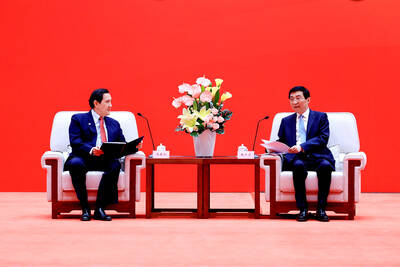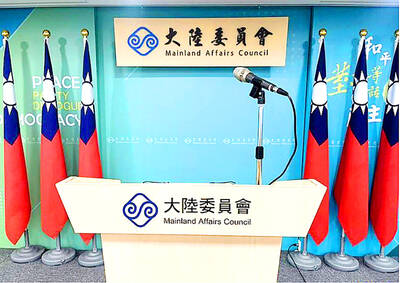The Straits Exchange Foundation (SEF) yesterday said it is planning to give two Formosan sika deer to the Fuzhou Zoo (福州動物園) in China as an olive branch, despite the military exercises by the Chinese People’s Liberation Army (PLA) on Monday.
While visiting Daciou Island (大坵) in Lienchiang County (Matsu), SEF Secretary-General Luo Wen-jia (羅文嘉) said that the foundation might coordinate with China’s Association for Relations Across the Taiwan Strait (ARATS) to send the two animals.
The deer are named He He (和和) and Ping Ping (平平), a play on the word for “peace” (heping, 和平), Luo said.

Photo: Chen Yu-fu, Taipei Times
Despite the differences in history, perception and understanding of the current situation, both sides of the Taiwan Strait must seek common ground to resolve issues peacefully, rather than resort to hatred or violence, he said.
The “deer of peace” would eventually give birth to fawns and continue to symbolize harmony in the future, he said.
They represent the aspirations and values of Taiwanese: hardworking, kind and passionate, he added.
Taiwan hopes to cooperate with China and its people over democracy, prosperity and peace, rather than provoke a war, as both sides have suffered aggression at the hands of outside powers and should seek to avoid such actions in the future, he said.
Luo referenced that China in 2008 gave Taiwan two pandas named Tuan Tuan (團團) and Yuan Yuan (圓圓), which was followed by another animal exchange in 2013 of orangutans and red pandas.
If the two sides cannot resolve political issues, the animals are a good way to start and promote peace, he added.
Meanwhile in an interview, Luo said that the so-called “1992 consensus” does not exist and cannot be used as the foundation for cross-strait exchanges.
The “1992 consensus” — a term that former Mainland Affairs Council chairman Su Chi (蘇起) in 2006 admitted making up in 2000 — refers to a tacit understanding between the Chinese Nationalist Party (KMT) and the Chinese Communist Party (CCP) that both sides of the Taiwan Strait acknowledge that there is “one China,” with each side having its own interpretation of what “China” means.
If the KMT and the CCP understand it to mean that there is only “one China,” then this does not align with mainstream public opinion in Taiwan, Luo said.
Accepting the “1992 consensus” would mean that the Republic of China would not exist, he added.
The best foundation for cross-strait engagement is the more than 20 pre-existing agreements signed between the SEF and ARATS, Luo said, adding that none of those agreements mention the “1992 consensus.”
If these agreements are not abided by, other issues such as Taiwanese arrested in China would be difficult to negotiate, he said.
Chinese President Xi Jinping’s (習近平) “1992 consensus” is essentially a version of Beijing’s “one country, two systems” for Taiwan, he said.
The KMT’s interpretation of the “1992 consensus” no longer includes the words “respective interpretation,” as former president Ma Ying-jeou’s (馬英九) meeting with Xi in April showed, he said.
Even without the “1992 consensus,” cross-strait talks are still possible on the basis of equality and dignity, he added.
The next round of cross-strait negotiations should be held on Matsu, he said.

CHIP WAR: The new restrictions are expected to cut off China’s access to Taiwan’s technologies, materials and equipment essential to building AI semiconductors Taiwan has blacklisted Huawei Technologies Co (華為) and Semiconductor Manufacturing International Corp (SMIC, 中芯), dealing another major blow to the two companies spearheading China’s efforts to develop cutting-edge artificial intelligence (AI) chip technologies. The Ministry of Economic Affairs’ International Trade Administration has included Huawei, SMIC and several of their subsidiaries in an update of its so-called strategic high-tech commodities entity list, the latest version on its Web site showed on Saturday. It did not publicly announce the change. Other entities on the list include organizations such as the Taliban and al-Qaeda, as well as companies in China, Iran and elsewhere. Local companies need

CRITICISM: It is generally accepted that the Straits Forum is a CCP ‘united front’ platform, and anyone attending should maintain Taiwan’s dignity, the council said The Mainland Affairs Council (MAC) yesterday said it deeply regrets that former president Ma Ying-jeou (馬英九) echoed the Chinese Communist Party’s (CCP) “one China” principle and “united front” tactics by telling the Straits Forum that Taiwanese yearn for both sides of the Taiwan Strait to move toward “peace” and “integration.” The 17th annual Straits Forum yesterday opened in Xiamen, China, and while the Chinese Nationalist Party’s (KMT) local government heads were absent for the first time in 17 years, Ma attended the forum as “former KMT chairperson” and met with Chinese People’s Political Consultative Conference Chairman Wang Huning (王滬寧). Wang

CROSS-STRAIT: The MAC said it barred the Chinese officials from attending an event, because they failed to provide guarantees that Taiwan would be treated with respect The Mainland Affairs Council (MAC) on Friday night defended its decision to bar Chinese officials and tourism representatives from attending a tourism event in Taipei next month, citing the unsafe conditions for Taiwanese in China. The Taipei International Summer Travel Expo, organized by the Taiwan Tourism Exchange Association, is to run from July 18 to 21. China’s Taiwan Affairs Office spokeswoman Zhu Fenglian (朱鳳蓮) on Friday said that representatives from China’s travel industry were excluded from the expo. The Democratic Progressive Party government is obstructing cross-strait tourism exchange in a vain attempt to ignore the mainstream support for peaceful development

DEFENSE: The US would assist Taiwan in developing a new command and control system, and it would be based on the US-made Link-22, a senior official said The Ministry of National Defense is to propose a special budget to replace the military’s currently fielded command and control system, bolster defensive resilience and acquire more attack drones, a senior defense official said yesterday. The budget would be presented to the legislature in August, the source said on condition of anonymity. Taiwan’s decade-old Syun An (迅安, “Swift Security”) command and control system is a derivative of Lockheed Martin’s Link-16 developed under Washington’s auspices, they said. The Syun An system is difficult to operate, increasingly obsolete and has unresolved problems related to integrating disparate tactical data across the three branches of the military,